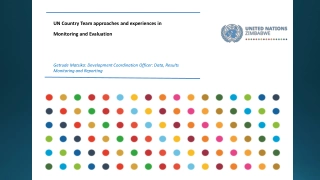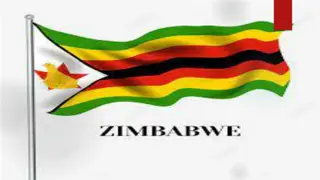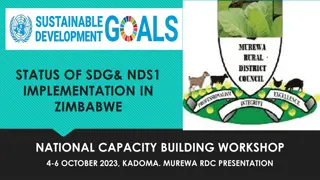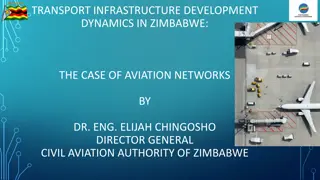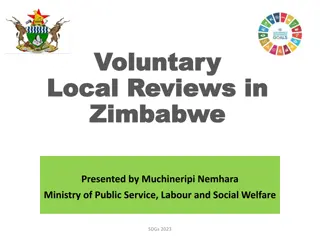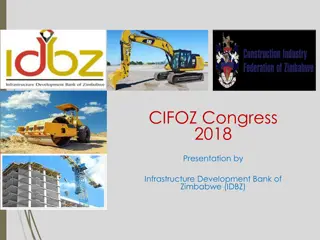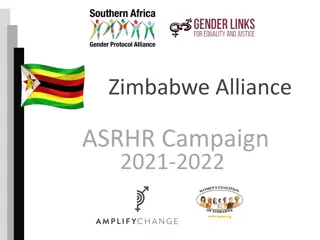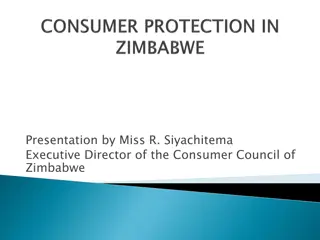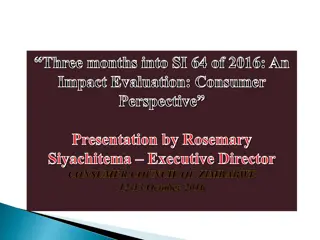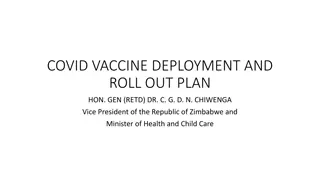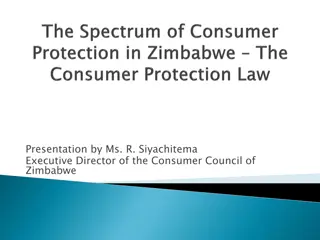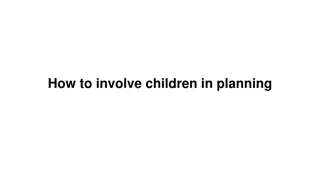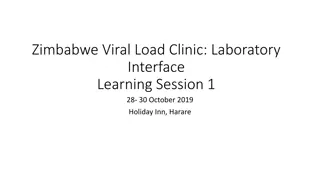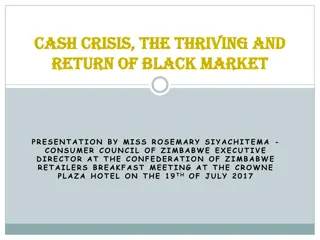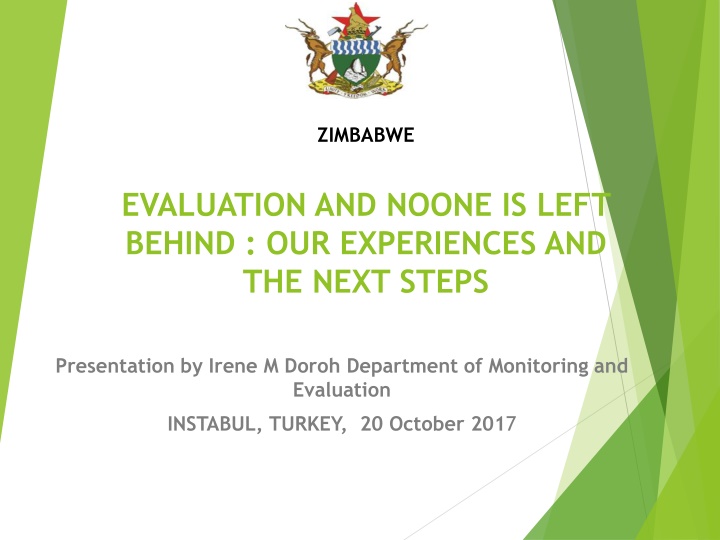
Evaluation and Progress in Zimbabwe: Our Experiences and Next Steps
Recognition of the importance of national evaluation capacities for successful development programs in Zimbabwe. Commitment to ensure no one is left behind through inclusive strategies and partnerships. Implementation modalities align with SDGs.
Download Presentation

Please find below an Image/Link to download the presentation.
The content on the website is provided AS IS for your information and personal use only. It may not be sold, licensed, or shared on other websites without obtaining consent from the author. If you encounter any issues during the download, it is possible that the publisher has removed the file from their server.
You are allowed to download the files provided on this website for personal or commercial use, subject to the condition that they are used lawfully. All files are the property of their respective owners.
The content on the website is provided AS IS for your information and personal use only. It may not be sold, licensed, or shared on other websites without obtaining consent from the author.
E N D
Presentation Transcript
ZIMBABWE ZIMBABWE EVALUATION AND NOONE IS LEFT BEHIND : OUR EXPERIENCES AND THE NEXT STEPS Presentation by Irene M Doroh Department of Monitoring and Evaluation INSTABUL, TURKEY, 20 October 2017
Outline of Presentation Introduction. Implementation modalities. Institutional Framework. Zimbabwe s Position on SDGs. Progress to date. Incorporation of lessons learnt and Next Steps
Introduction Recognition that enhanced national evaluation capacities are a panacea for the successful implementation of development programmes and projects We are ready as a country to innovate and develop effective, accountable, participatory and transparent institutions at all levels to ensure efficient use of public resources for the services and benefits of all citizens The pursuit for improvements in the quality of life has remained a global priority and indeed also a national priority for Zimbabwe
Introduction Zimbabwe s commitment to ensure that no one is left behind has been a key feature in all Government programmes and the discourse shaping the Agenda 2030 The fact that no goal should be met unless it is met for everyone is well pronounced Leaving no one behind requires not only targeted focus on the vulnerable[youth, children, women, elderly, persons living with disabilities, poor]
Introduction But participation and concerted efforts to build partnerships Government, civil society, private sector, development partners to ensure programmes are successfully implemented emphasis should be on between
Implementation Modalities The Post-2015 Development Agenda is being implemented within Development Plan, the Zimbabwe Agenda for Sustainable Transformation (ZIM architecture of the 4 core Clusters and 3 enabling Sub-Clusters our National Socio-Economic ASSET), and its It is anchored on the RBM system All the SDGs have been integrated into these clusters for ease of implementation and ensuring synergies between the SDGs and the country s economic blue print the ZIMASSET
Implementation Modalities For reporting purposes, ease of data collection and consistency in Reporting, 2015 was adopted as the base year in the implementation of the SDGs. Key partners: Given the breadth of the SDGs Agenda, which now incorporates the three pillars of sustainable development (Economic , Social and Environmental) and the magnitude of the resources (human and financial) that is required to implement the Programmes, a Multi-stakeholder approach has been adopted to augment Government efforts. As stated in the Post-2015 Development Agenda, Governments alone (especially in the developing world) will not be able to implement the SDG Agenda on their own. The key partners will also be involved in the Financing, Implementation, Monitoring and Evaluation of the SDGs.
Implementation Modalities These stakeholders include: Government (national and sub-national structures); Parliamentarians; Private Sector (both Foreign);Civil Society Development Partners; Organisations; Women s Organisations, Local Authorities, Organisations and representing PLWD, the Elderly and the general citizenry. Chiefs; Parastatals; Domestic Organisations; and Youth Faith organisations Based
Institutional Framework Cabinet Steering Committee SDG Technical Commitee Secretariat SDGs 3 Clusters 4 1 2 5 6
Institutional Framework Cabinet As the supreme policy making body in the country, it is responsible for considering all policy issues pertaining to the SDGs in the country as well as reports from the Steering Committee including the SDG Annual Country Report before its submission to the UN.
Institutional Framework Steering Committee This Committee comprises of Permanent Secretaries, Cluster Chairs and Co-Chairs, Heads of UN Task Force Agencies, the Private Sector, Parastatals and Donors and is chaired by the Chief Secretary to the President and Cabinet or his designate. This committee meets twice per year to consider the reports from the Technical Committee and give policy guidance in the implementation of the SDGs in the country. It is responsible for preparing reports to Cabinet.
Institutional Framework The Technical Committee The Technical Committee comprises of the Cluster Chairs and Co-Chairs, SDG focal persons and representatives of all key stakeholders in the Cluster, it is chaired by the Secretary for Macro-Economic Planning and Investment Promotion. It is responsible for receiving the quarterly reports of the Clusters and in turn prepare reports for submission to the next committee in the hierarchy. It is also responsible for directing and working closely with the Secretariat to ensure that the events and activities necessary implementation of the SDG Agenda are undertaken. for the smooth
Institutional Framework The SDG Clusters These are the Working Groups consisting of all institutions responsible for the implementation of policies, projects and programmes key in the attainment of the SDGs, targets and indicators. Included in the Clusters are SDGs Ministry s focal persons. The Clusters comprise of representatives of all stakeholders who have an interest in the topical issue/s dealt with by that group or Cluster. These include Government, civil society, development partners, the donors, the private sector, parastatals, organisations, Women s groups, people with disabilities, the Elderly, Philanthropists, professional bodies etc. Faith based Youth groups,
Institutional Framework Secretariat The Secretariat, constituting of the Office of President and Cabinet, Ministry of Macroeconomic Planning and Investment Promotion, UNDP responsible for organising and co-ordinating key SDG activities and production of the necessary documentation. The envisaged activities National Launch, Roll Out Plan, Advocacy campaign, establishment structures, reporting structures, interacting with Clusters etc. and ZIMSTAT are include the of Provincial
Zimbabwes Position on SDGs In coming up with its position on SDG s, Government undertook a wide consultation process which entailed Multi-stakeholder Workshops and several follow up meetings. The stakeholders included Government, Private Sector, Civil Society, Academia, UN Agencies and other Development Partners.
Zimbabwes Position on SDGs The Country Position Paper is meant to; Raise awareness on the SDGs agenda; Align the SDGs to the existing National Development Plan (ZimAsset ) Clusters and enabling-Clusters; and Prioritise the SDGs in terms of implementation.
Zimbabwes Position on SDGs Government decided that it would implement all the 17 Sustainable Development Goals as they are deemed to be important to the country. However, in terms of emphasis andguided by the country s vision, the need to concentrate on enabling Goals, resource availability and MDGs unfinished business, decided that focus would be on the following ten SDGs:- Goals 8, 7, 2, 9, 6, 13, 17, 3, 4 and 5 Government
Rationale for the focus SDGs Goal 8: Economic Growth : Sustained and inclusive economic growth is necessary if we are to create wealth which can be channeled to the social sectors, create economic opportunities for citizens to go into business or to become gainfully employed. Goal 7: Energy: Energy is critical for all sectors of the economy to be fully functional and productive. Goal 2: Agriculture, Food Security and Nutrition: Sustainable Agriculture is the bedrock of our economy) and the bulk of our population derive their livelihood from this sector. (Also important are the attendant food security and nutrition aspects). Economy (agro-based
Rationale for the focus SDGs Agriculture is the mainstay of the economy as emphasised in Zim Asset and the ten point plan. Goal 9: Infrastructure: Resilient infrastructure, Industrialisation and Innovation are again key in promoting sustainable economic growth. Zim Asset and the Ten Point Plan also emphasise on the importance of infrastructure development. Goal 6: Water and Sanitation: Availability and sustainable management of Water and Sanitation are key in supporting all sectors of the economy. No sector can function without water, these are key enablers in the Zim Asset and the Ten point plan.
Rationale for the focus SDGs Goal 17: Means of implementation and Revitalised Global Partnerships are key in the implementation of the Agenda since there is outright acknowledgement that domestically mobilised resources will not be enough to finance the SDG Agenda. Financing will require much more players than Government alone. The country needs both foreign and domestic investment for it to grow. Private sector participation is critical in the Ten Point Plan.
Rationale for the focus SDGs Goal 3 (Health ) For the economy to grow it will require healthy people. The relationship between a healthy nation and economic growth is pivotal. Health is key in improving labour productivity and hence economic growth. Goal 4 : (Education ) Quality education is key in imparting the necessary skills required in all sectors of the economy and enhancing labour productivity.
Rationale for the focus SDGs Goal 13 (including the anchor sector of Agriculture) depends on the Environment. There is therefore urgent need to combat climate change and its negative impact on the Environment. Goal 5: Gender and Women achievement of full human potential and sustainable development is not possible if one half of humanity continues to be denied its full potential of sustainable development. Economic Empowerment of women and girls is therefore imperative for them to participate in all sectors of the Economy. Combating Climate Change: The economy Empowerment: The
Rationale for the focus SDGs Focus on the above mentioned Goals will trigger activity in the remaining seven, leading to the ultimate Goal of Eliminating Poverty in all its forms everywhere. However, implementation of policies, projects, and programmes on all the SDGs will continue to be implemented working in collaboration with development partners and the private sector.
Gender Responsive M & E Guidelines The state of play of the monitoring and evaluation of gender equality and equity in the country The Zimbabwe Constitution of May 2013 has strong provisions for the promotion and attainment of gender equality and women s empowerment To this end, Government has created an enabling environment for the promotion of gender equality and women s empowerment There is intense promotion of these key principles of gender equality and equity focused perspectives into the existing systems of governance Notwithstanding the challenges that might arise from time to time be they political or structural
Gender Responsive M & E Guidelines Men and women experience life differently, have different needs and priorities and are affected differently by policies and interventions and therefore is need to ensure that all evaluations undertaken are gender responsive There is consensus that gender responsive evaluations are central to the Government s policy formulation, planning, programming and resource allocation and enables it to achieve its stated results in Zim ASSET, the 10 Point Plan and the prioritised 10 SDGs To this end Government and UN are in the process of developing gender responsive National Monitoring and Evaluation guidelines The development of the guidelines will be guided by the M & E policy principles mainly among others of ownership and inclusivity and gender equality and equity
Gender Responsive M & E Guidelines A tool to complement the M & E Policy and an elaboration of the Policy that further goes to illustrate to users how to conduct gender responsive national evaluations undertaken by Government ministries and other stakeholders UN support both financially and technically will ensure integration of gender in all phases of the evaluation process in terms of planning, implementation activities, usage and dissemination of data, information in terms of roles and responsibilities of key players A consultant engaged and has already implementing a participatory process that will lead to the development of the guidelines
Gender Responsive M & E Guidelines Rapid Results Initiative adopted 100 day period Production of the first draft [Zim ASSET Focal persons, gender and evaluation experts]
Progress to Date Focal Persons have been identified in all the line Ministries who will continue to play a key role in coordinating issues at Ministry level. SDGs sensitisation meetings engaging Members of both the Lower and Upper Houses of Parliament were held in 2016 and 2017. We have finalised the Zimbabwe SDG targets and indicators framework.
Progress to Date Following consultations with stakeholders, baseline data has been obtained for selected indicators. collection is continuing in collaboration with ZIMSTAT. Main reason is that some of the indicators are being tracked by line Ministries and the statistical agency. Efforts are underway to ensure line Ministries collect administrative data and ZIM STATS carry out all the necessary survey. In this regard there is therefore urgent need to capacitate the statistical agency so that we have the critical statistical data necessary in the evaluation of SDGs going forward. Baseline data
Progress to date Participated in several local, regional and international seminars on SDGs. Government produced a report on Voluntary National Reviews presented at the High Level Political Forum (HLPF), that was held in New York in July 2017 at the UN. (VNRs) which was Among the 44 countries [7 from Africa] that demonstrated readiness to undertake the reviews Building on the successful participation of Zimbabwe at the UN High Level Political Forum
Lessons Learnt and Next Steps Following the lessons drawn from the experiences of other presented the status Implementation at the 2017 Voluntary National Reviews, the country will focus on: Embracing SDGs in the national budgeting formulation process; Enhancing private sector involvement to bridge the huge financing gap that exists; countries of their who SDGs
Lessons Learnt and Next Steps Strengthening multi-stakeholder participation in all processes and at all levels i.e national, provincial and district level; Urgently addressing structural barriers to gender equality and the empowerment of all women and girls to enhance their participation in the economic development process
Lessons Learnt and Next Steps Recognition of children, adolescents and the youth as important agents of change and underline the necessity of investing in them, with a view to addressing multidimensional deprivations, reducing poverty, harnessing the demographic dividend and empowering them to build a more prosperous future; Increasing public awareness, knowledge and perceptions of SDGs;
Lessons Learnt and Next Steps the National Agency (ZIMSTAT) to effectively address the data requirements of the 2030 Agenda. Capacitating Statistical There is need to continuously improve collection, analysis and dissemination of high quality, reliable and timely data, disaggregated by sex, ethnicity, disability, region and other relevant variables; and Improving authorities to create a critical mass around sustainable development. the involvement of local
Lessons Learnt and Next Steps The Government is embarking on nationwide provincial information dissemination workshops, which have the following objectives:- To create public awareness to SDGs, targets and indicators; To reinforce the need for common action to achieve the SDGs targets by 2030; To present a forum for discussion, exchange of ideas and engagement of stakeholders on the Post 2015 Development Agenda implementation strategy; and To capacitate and involve Provincial and District authorities in SDGs implementation.
END I thank you for your attention
Implementation Modalities cont d Clusters Relevant SDGs 1,2,3,6, 12,13,14 and 15 1. Food Security and Nutrition 2.Infrastructure and Utilities 3,7 and 9 3.Value Addition and Beneficiation 9 and 12 4.Social Services and Poverty Reduction 3,4 ,5 and 6 5.Public Administration and Governance 8,10,11 and 16 6.Fiscal Reform Measures 8,10 and 17

